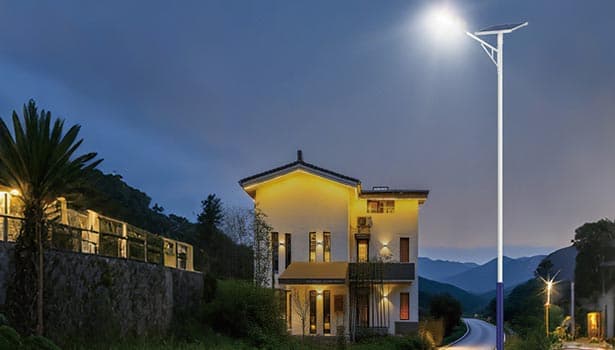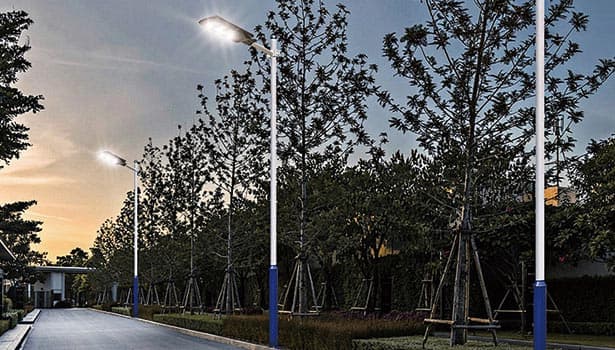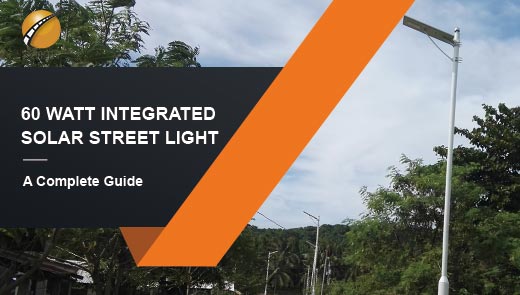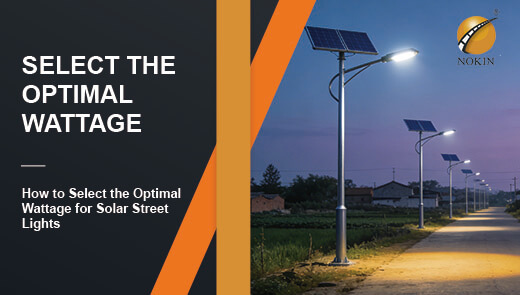Solar Street Lights for Community Paths
Community paths are a vital link connecting residents' daily lives. Whether it's morning exercise, evening strolls, or nighttime leisure outings, reliable lighting is essential. Traditional street lights rely on the power grid, consume high energy, and require cumbersome maintenance. Solar street lights, with their unique advantages, are becoming an ideal choice for community path lighting. This article will delve into why solar street lights are suitable for community paths, as well as how to effectively plan, select, and maintain them, ensuring a safe and environmentally friendly night in the community.

Why Choose Solar Street Lights for Community Path Lighting?
Disadvantages of Traditional Street Lights
High energy consumption and cost
Traditional street lights rely on the power grid, so electricity bills must be paid for their use. They are also highly susceptible to grid failures. High electricity bills and frequent circuit repairs place a heavy burden on community management.
Installation limitations
Renovating the lighting system for older community paths requires extensive road construction to lay cables. This massive and time-consuming project not only consumes significant manpower and financial resources, but also impacts the lives of community residents.
Safety hazards
Due to power grid constraints, traditional street lights may go out due to line failures, plunging community roads into darkness and posing a safety hazard to elderly people and children traveling at night.
Advantages of Solar Street Lights
Electricity cost savings
Solar street lights rely on free solar energy. During the day, solar panels collect sunlight and convert it into electricity, which is stored in batteries. At night, the LED lights automatically illuminate, eliminating reliance on the traditional power grid and high electricity bills, reducing financial pressure on the community.
Easy installation
One of the advantages of solar street lights is their quick and easy installation. Since they don't require a connection to the power grid, there's no need for trenching or wiring, significantly reducing the amount of work and shortening the construction period. Installation simply requires securing the pole and attaching the lamp head to it (for all-in-one solar street lights). This safe and efficient installation process doesn't disrupt the daily lives of community residents.
Independent power supply
Another advantage of solar street lights is their independent power supply. They operate independently, providing a completely independent energy source. They don't rely on external power sources, and even if the power grid fails, they can still operate normally. For community paths, ensuring stable and uninterrupted lighting is crucial.
Seven Values of Solar Street Lights for Community Paths
Cost Reduction and Efficiency Improvement
For community managers, the annual electricity bill for lighting equipment is a significant expense. While traditional street lights are cheaper to purchase than solar ones, the annual electricity bill still places a heavy financial burden on the community. Solar street lights, on the other hand, although initially costly, are a highly cost-effective investment. Once installed, they eliminate electricity costs and reduce maintenance costs. In the long run, they offer a cost-effective and efficient option for community managers.
Improving Community Safety
Adequate lighting is crucial for maintaining a safe community environment at night. Without bright light, pedestrians and children playing at play struggle to detect puddles, depressions, or bumps on the ground, making them prone to falls. Safety hazards on dark corners of community paths often stem from insufficient lighting. Dim lighting makes it difficult for pedestrians to detect puddles, debris, or bumps, making falls more likely. Dark corners can also become blind spots, increasing safety risks.
Solar street lights use LED light sources, providing uniform and stable illumination that clearly displays path details. Equipped with intelligent light-sensing control, they automatically illuminate at dusk and shut off at dawn, ensuring continuous illumination from sunset to sunrise. In addition, some models are equipped with a presence-sensing function (lights on when someone approaches and dims when someone leaves), ensuring ample brightness when pedestrians pass by while avoiding energy waste when no one is around, thus balancing safety and energy conservation.

Green and Environmentally Friendly
In the context of global carbon neutrality, communities, as the fundamental units of cities, are crucial for implementing environmentally friendly measures. Traditional streetlights rely on thermal power generation, with each 100W streetlight indirectly emitting approximately 300 kilograms of carbon dioxide annually. Solar streetlights, on the other hand, generate electricity by absorbing sunlight, achieving zero emissions and pollution, fully meeting the standards for green community construction.
For example, a community path equipped with 20 solar streetlights can reduce carbon dioxide emissions by approximately 6 tons annually, equivalent to the environmental benefits of planting 300 trees. This "visible environmental protection" not only enhances the community's ecological image but also subtly cultivates low-carbon awareness among residents.
Stable and Reliable
Power outages caused by extreme weather or power grid failures often render traditional streetlights inoperable. However, lighting along community paths, as vital evacuation routes, is particularly critical during these times. The independent energy storage design of solar street lights perfectly solves this problem. Built-in lithium batteries store sufficient energy during the day to maintain normal lighting even during 3-5 consecutive days of rainy weather or power outages.
This grid-independence feature is particularly important during disasters such as typhoons and heavy rain, providing a fundamental guarantee for community emergency management.
Low-Maintenance Features
Traditional street light maintenance can be a hassle: aging wiring requires frequent inspections, and the short lifespan of bulbs (approximately one year) requires regular replacement. Each maintenance can disrupt residents' access. Solar street lights, on the other hand, have a simple structure, and their core components (solar panels, LEDs, and lithium batteries) have a lifespan of over five years. Routine maintenance requires only two tasks:
Clean the solar panel surface from dust quarterly to ensure optimal lighting performance;
Inspect the battery cables annually to prevent loosening.
This low-intervention maintenance model significantly reduces the manpower required by community property management, making management more efficient.
Flexible Adaptability
Solar street lights are adaptable to any location, whether it's a standardized promenade in a new community or a winding path in an older residential complex. Installation doesn't require consideration of the power grid, making them easy to illuminate even remote corners.
For communities where the original landscape needs to be preserved (such as promenades with trees and flowers), solar street lights feature adjustable pole heights (typically 3-5 meters) and rotatable lamp heads. This avoids obstruction of vegetation while ensuring optimal lighting coverage, achieving a harmonious coexistence of "lighting and landscape."
Aesthetic and Intelligent
Modern solar street lights are designed to blend in with their surroundings. The poles are made of aluminum alloy or steel and can be painted in colors that coordinate with the community architecture (such as off-white, light gray, or dark brown). Their simple, streamlined design doesn't disrupt the aesthetic of the promenade.
The addition of smart features adds even more value: in addition to the aforementioned motion sensing, some high-end models support remote monitoring (checking each light's operating status via a mobile app) and brightness adjustment (automatically reducing brightness late at night to save power), making community management more convenient and energy efficient.
Site Assessment Before Installing Solar Street Lights on Community Paths
Not all community paths are suitable for direct installation of solar street lights, as site conditions can directly impact their effectiveness. Before installation, complete the following four core assessments to ensure project success.
|
Assessment Dimensions |
Core Criteria |
On-site Inspection Methods |
Ignoring Risks |
|
Sunlight Conditions |
≥ 4 hours of direct sunlight daily |
Observe sunlight exposure at the proposed installation site at 9:00 AM, 12:00 PM, and 3:00 PM; record shading duration from trees/buildings for 7 consecutive days (including cloudy days), then average the results. |
Insufficient battery power leading to early light shutoff or dim lighting at night |
|
Temperature Adaptability |
Winter extreme low temperatures ≥ -10°C (lithium battery tolerance) |
Refer to the lowest local winter temperatures over the past 5 years. If below -10°C, choose lithium batteries rated for low temperatures. |
Battery capacity drops sharply in low temperatures, shortening lighting duration |
|
Security and Anti-theft |
No frequent thefts near the path; stable light pole installation |
Ask property management or residents about public facility theft history; ensure the installation site is hard ground (e.g., concrete) to avoid tilting poles. |
Theft of solar panels or batteries causing equipment damage and financial loss |
|
Policy Compliance |
Complies with local regulations for public facility installation |
Confirm with the neighborhood committee or urban management whether registration is needed, whether pole height is restricted, or if there are unified appearance requirements. |
Risk of forced removal due to non-compliance, resulting in reinstallation costs |
Special Situation Handling Suggestions:
- If sunlight is insufficient (average 2-4 hours of direct sunlight per day): Choose a solar panel with slightly higher power (e.g., increasing from 100W to 120W) or relocate the pole to an area with more sunlight.
- If there is a minor theft risk: Choose a battery box with anti-tamper screws (requiring special tools to open) and install an anti-theft base at the bottom of the pole (secured to the ground).

Community Path Solar Street Light Selection Guide
Select solar street light parameters based on the width, foot traffic, and frequency of use of your community path. The following are recommended selection parameters for key parameters:
Power and Brightness
- For narrow walkways (1-2 meters, such as recreational paths within a residential complex): Choose a 30-50W streetlight with a brightness of 3,000-5,000 lumens (equivalent to a traditional 150-250W incandescent lamp), with poles spaced 10-15 meters apart.
- For wide walkways (2-4 meters, such as the main walkway connecting the residential gate and the central square): Choose a 60-100W streetlight with a brightness of 6,000-10,000 lumens, with poles spaced 15-20 meters apart.
Note: Brightness is not always better. Excessive brightness can cause light pollution. The standard is to ensure that road details are clearly visible without glare.
Battery Capacity
The lithium battery is the "energy storehouse" of the solar street light. Its capacity must be sufficient to keep the light running for three consecutive rainy and cloudy days. The calculation formula is:
Battery capacity (Ah) = (Street light power in W ÷ Voltage in V) × Daily lighting hours in h × 3 days ÷ 0.7 (battery depth of discharge)
For example: A 60W street light (operating voltage 12V) running for 10 hours per day requires a battery capacity of (60 ÷ 12) × 10 × 3 ÷ 0.7, which is approximately 171Ah. In practice, 180Ah is sufficient.
Solar Panel Type
|
Solar Panel Type |
Conversion Efficiency |
Low-Light Performance (Cloudy Days) |
Price |
Recommended Scenario |
|
Monocrystalline Silicon |
18%–23% |
Good |
High |
For community paths with average sunlight conditions |
|
Polycrystalline Silicon |
15%–18% |
Average |
Low |
For paths with ample sunlight (average daily direct sunlight ≥ 6 hours) |
Community paths are often shaded by trees, so monocrystalline silicon solar panels are recommended to ensure effective charging even on cloudy days.
Protection Level and Durability
Solar street lights are exposed to the outdoors for extended periods and must be waterproof, dustproof, and windproof:
- Protection Level: At least IP65 (completely dustproof and resistant to low-pressure water jets); IP66 is recommended for rainy areas;
- Wind Resistance: ≥ Level 12 (resistant to typhoon-strength winds);
- Light Pole Material: Preferable hot-dip galvanized steel (corrosion-resistant) or aluminum alloy (lightweight and rust-resistant), with a thickness of ≥ 2.5mm to ensure longevity.
Smart Features
Community paths don't need to be "all-inclusive" in their smart features; practicality is key:
- Basic: Light sensor control (automatically turns off at sunrise and on at sunset) + timed dimming (e.g., brightness is reduced to 50% after 11 PM);
- Advanced: Light sensor control + motion detection (sensing distance 5-8 meters, 30-second delay), suitable for paths with low foot traffic;
- High-end: Adds remote monitoring, suitable for large communities (paths over 1 km long) for centralized management.
Installation and Maintenance of Community Path Solar Street Lights
Community Path Solar Street Lights Installation Steps
Foundation: Pour a concrete base (approximately 50cm x 50cm x 60cm, 60cm deep) at the selected location. After solidifying (usually 7 days), secure the light pole to the base with expansion screws.
Component Installation: Secure the solar panel to the top of the light pole (tilted 30°-45° south to maximize direct sunlight exposure). Install the light head 2.5-3.5 meters above the ground. Secure the battery box to the bottom of the light pole (no separate installation required for an integrated design).
Commissioning and Startup: Connect the wiring (be careful not to reverse polarity), turn on the power, and test the light sensor and sensing functions to ensure they are functioning properly. Confirm that the lighting mode (such as brightness and sensor sensitivity) matches the preset settings.
Community Path Solar Street Lights Daily Maintenance
Regular Cleaning: Wipe the solar panel surface with a dry cloth or clean water every quarter (avoid scratching with hard objects) to remove dust and fallen leaves to ensure efficient lighting.
Condition Inspection: Perform monthly inspections to check for tilted poles, loose wiring, and damaged lamp heads. Repair any problems promptly.
Battery Maintenance: Check the battery voltage annually (measured with a multimeter; it should normally be between 12V and 13.5V). If the voltage is too low (<11V), it may be due to battery aging and requires prompt replacement (lithium batteries have an approximate lifespan of 5-7 years).

NOKIN Solar Street Lights: An Ideal Choice for Community Paths
NOKIN, a brand specializing in outdoor solar lighting, has designed its community path solar street lights with these requirements in mind, offering the following advantages:
- High-efficiency monocrystalline silicon solar panels and low-temperature lithium batteries ensure operational performance even in temperatures as low as -15°C;
- IP66 protection and 12-level wind resistance adapt to various climates;
- Three optional smart modes to meet the needs of diverse communities;
- A three-year warranty ensures worry-free community management.
Whether renovating an existing community or planning a new one, NOKIN solar street lights provide a stable, environmentally friendly, and economical lighting solution for paths.
Conclusion
Upgrading community path lighting is more than just a matter of "lighting up"; it's a crucial initiative to enhance residents' well-being and promote sustainable community development. With their zero-energy consumption, high safety, and easy maintenance, solar street lights perfectly meet the needs of modern communities—lighting residents' pathways while also illuminating a green and low-carbon lifestyle.
Through scientific site assessment, reasonable product selection and standardized installation and maintenance, solar street lights will become an "invisible landscape" in the community, making every night trip safe and comfortable, and filling the community's nights with warmth and vitality.




